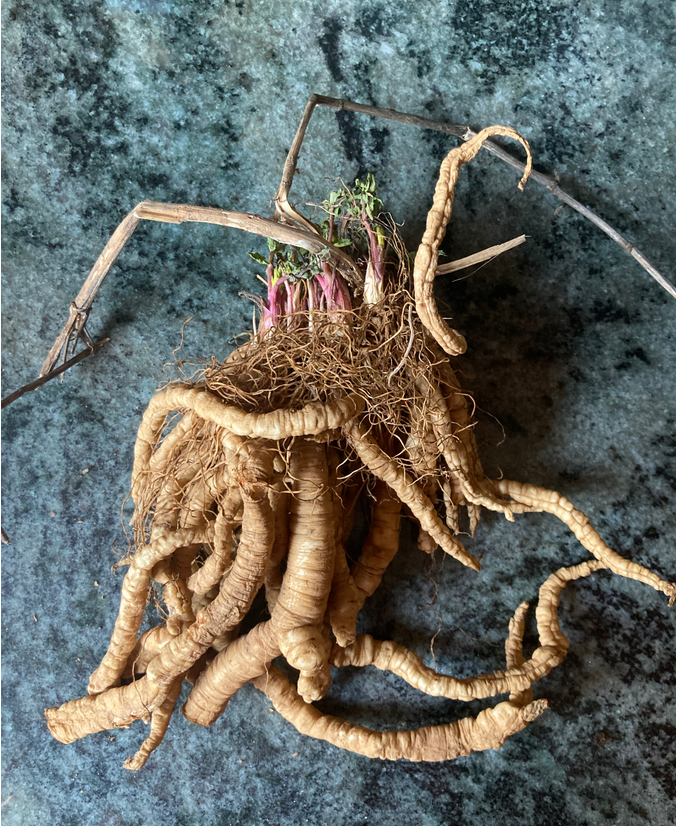THREAD:
Skirret, Salsify, Scorzonera...
These are root vegetables, once popular, and eaten in almost every meal, in a pottage style stew mainly; it was the staple of many farmers...
What happened to them? Why don't we eat them any more?
1/x

Skirret, Salsify, Scorzonera...
These are root vegetables, once popular, and eaten in almost every meal, in a pottage style stew mainly; it was the staple of many farmers...
What happened to them? Why don't we eat them any more?
1/x


The thing is, since the arrival of potato and sweet potato, the two of them replaced the fiddly, soil-clinging roots above, with big, nutritious tubers from South America! Commercial production of these new vegetables was easier, hence, the old fashioned staples,
2/x

2/x


the vegetables grown for hundreds of years, -with often a more complex flavour- have been all but lost. An added bonus of skirret, salsify, scorzonera is that they do thrive in the northern, wet cold climes so don't need special care &have their own unique flavour.
3/x
3/x

From Wikipedia: "The vegetable called salsify is usually the root of the purple salsify, Tragopogon porrifolius; the root is described as having the taste of oysters (hence the alternative common name "oyster plant" for some species in this genus), 4/x 

but more insipid with a touch of sweetness. The young shoots of purple salsify can also be eaten, as well as young leaves. Other species are also used in the same way, including the black or Spanish salsify, Scorzonera hispanica, which is closely related though not a member"
5/x
5/x
By far the most common one I tend to notice occasionally in articles, and in greengrocers is Salsify;
"Salsify is similar in looks to parsnip: it has a long, slender taproot with creamy flesh hidden behind a tough, usually dark-tan skin. Sometimes called the 'oyster plant'
6/x
"Salsify is similar in looks to parsnip: it has a long, slender taproot with creamy flesh hidden behind a tough, usually dark-tan skin. Sometimes called the 'oyster plant'
6/x
because of its mild oyster-like taste, the roots can be used in much the same way as any other root vegetable – mashed, boiled or roasted. Its edible pink blooms make it a showstopper worthy of inclusion in the ornamental border. 7/x
Oh, you can eat the new shoots as spring greens, making this a very versatile crop choice!" The root is similar in appearance to a long, thin parsnip, with creamy white flesh. In the same way as many root vegetables, salsify can be boiled, mashed or used in soups and stews. 8/x
Next up, skirret: It has a floury texture, a little like a potato, due to the high starch levels. Its taste is unique, but vaguely carroty, not surprisingly as it comes from the multi-talented carrot family (Apiaceae). 9/x 



It needs v.little cooking. A minute or 2 boiling is enough, or you can briefly pan fry it.Skirret is quite easy to grow once you know how. Unlike most of its relatives it is not a biennial with a single taproot but a perennial that produces a whole shaggy bunch of roots.
10/x
10/x

A dormant skirret plant can therefore be lifted, divided and replanted like any clump-forming perennial. Grown from seed, skirret produces a single ‘crown’: several shoot buds around the base of a stem, with a cluster of roots attached
11/x
11/x

Grown on, this crown will divide to form a clump made from several crowns. The clumps are easy to tease apart into individual crowns again. It doesn’t mind exposed or maritime sites, and seems to actively enjoy the cold, one of the reasons it was popular in Scotland,
12/x
12/x
where it was known as crummock. Its wild ancestor grows on the banks of waterways (another name for it is “water parsnip”). As umbellifers, they look like mini cow parsley with froths of tiny white fragrant flowers to give a fluffy look.”
13/x

13/x


They grow to about 2ft high and attract insects, especially lacewings. Historical growers and chefs at Hampton Court, found that you don’t even need to peel them – just give them a good scrub and they’re delicious. even eat them raw straight out of the garden!
14/x
14/x

In the kitchen skirret needs a light touch. Its delicate nature is easily lost – even puréeing can lose some of the subtlety. Celebrate it on its own. Eat it raw or cube it up and fry it in butter with a little garlic, in an iron pan if possible.
15/x
15/x

The Tudors, who delighted in “sallats”, added skirret to salads as we might spring onions or radishes. Try serving it on a bed of rocket, one of their favourite salad leaves!
16/x
16/x

Lastly, scorzonera: This one, which is cultivated for its edible root, said to taste like asparagus. The whole plant is edible.
The Scorzonera sweet, is a crystallized dessert made Évora, Alentejo, Portugal.
17/x

The Scorzonera sweet, is a crystallized dessert made Évora, Alentejo, Portugal.
17/x


The "black salsify" -Scorzonera- is considered nutritious: it contains proteins, fats, asparagine, choline, laevulin, as well as minerals such as potassium, calcium, phosphorus, iron, sodium, and vitamins A, B1, E and C.
18/x
18/x

The growing plant is said to repel carrot root fly from carrots growing nearby. How to eat: Root - cooked. A sweet flavour. The root is usually eaten at the end of its first year of growth, but it can be grown on for a second year without becoming tough. Leaves - raw.
19/20
19/20
The tender young shoots are usually eaten in early spring.Flower buds-raw.Added to salads. The petals have their own distinctive flavour, can also be added to salads.
Go forth and experiment!
If you want more food and history listen here: shows.acast.com/the-delicious-…
20/20
/END
Go forth and experiment!
If you want more food and history listen here: shows.acast.com/the-delicious-…
20/20
/END
And another thread me cooking salsify gratin!
https://twitter.com/DeliciousLegacy/status/1497883756849512449
• • •
Missing some Tweet in this thread? You can try to
force a refresh







